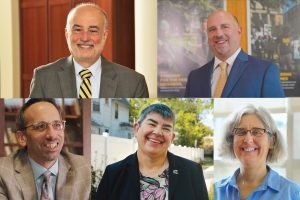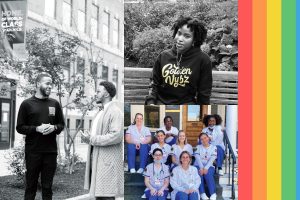Assistant Professor of Microbiology Kelly Hallstrom: Big answers from our tiniest life forms
December 13, 2021 · Campus News
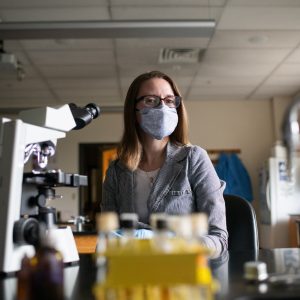
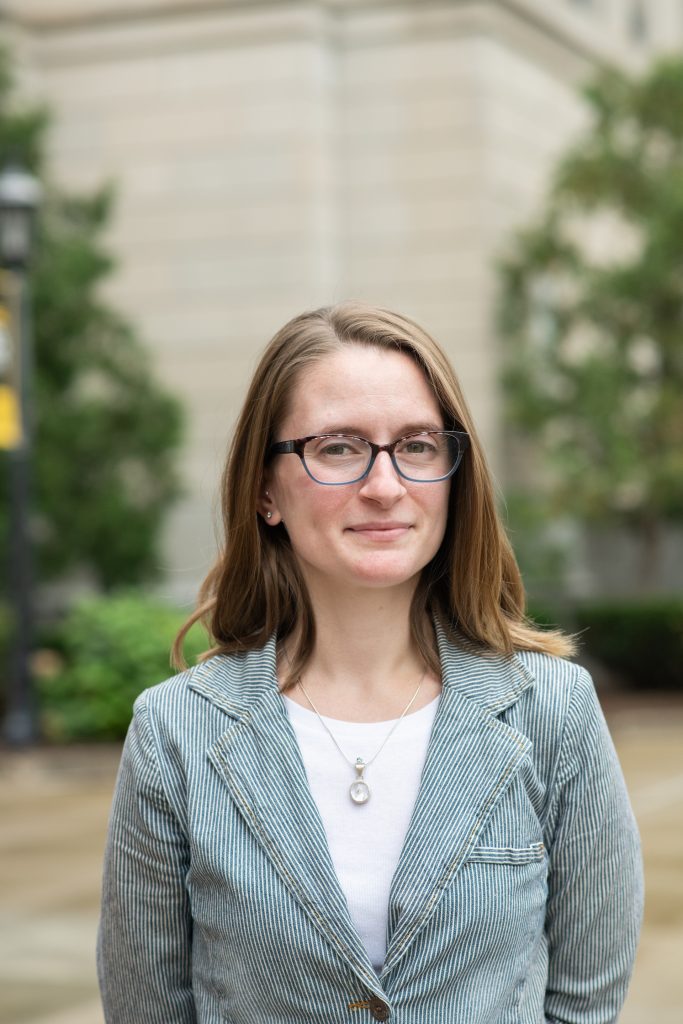 By the time she encountered the writings of Carl Sagan in high school, Dr. Kelly Hallstrom knew her future was in science. Propelled by Sagan, she thought she’d devote herself to studying the stars. She has, instead, zeroed in on some of our smallest life forms.
By the time she encountered the writings of Carl Sagan in high school, Dr. Kelly Hallstrom knew her future was in science. Propelled by Sagan, she thought she’d devote herself to studying the stars. She has, instead, zeroed in on some of our smallest life forms.
An assistant professor of microbiology who has been at Saint Rose for four years, Hallstrom studies microbes. Measuring a fraction of a millimeter, these include the bacteria, viruses, fungi, algae, and other microscopic organisms most people would rather avoid. They are, in fact, tiny forces of nature that inflict considerable damage, à la E. coli, salmonella, and COVID-19. But, as Hallstrom notes, microbes – billions grow in our bodies as part of our biomes – are essential to sustaining life. Understanding them sheds light on the causes of, and cures for, Lyme disease and food contamination – not to mention the future of energy sources.
Hallstrom studies microbes in soil, water, and our own bodies. On top of teaching students ranging from nonscience majors to future nurses and clinicians, she keeps up with the world of tiny living things so she is ready when a student wants to join her research. We asked her to tell us about it in her own words.
Was it always science?
Oh yes, oh yes, oh yes. From high school, when I encountered Carl Sagan, I wanted to communicate about science – either write about it or talk about it. There’s so much science around us that makes such a big difference in our daily lives and still a lot we don’t know.
I went from wanting to be a paleontologist, to wanting to be a storm chaser, to wanting to be an astronaut, to wanting to be an astronomer – being an astronomer was a pretty big dream for a while. But I went from looking at the big things to little things.
Why microbes?
I remember in middle school looking at an encyclopedia of infectious disease, because that’s what I did for fun back then. I saw pictures of all these pathogens, and I remember sitting there in the living room and thinking, “Here are things we can’t see with our own eyes. How can they do so much damage to our bodies?” I don’t know if I could handle seeing someone sick with a nasty infection, but when I saw the pictures of the pathogens, I wanted to keep looking.
On the paradox: When I went to college (Clark University), we learned about the good side of microbes: microbes in the soil, microbes that we need to be here, the probiotics that we eat and the bacteria that help plants grow. But the good and bad are all mixed. For example, there are harmless E. coli, there are dangerous E. coli. I started to see just how broad the field of microbiology is and how many opportunities there are to ask questions and experiment.
When I got a Ph.D. in biomedical sciences (University of Massachusetts Medical School), my work was on salmonella – we wanted to know how these bacteria make us sick.
We learned salmonella bacteria use proteins to turn our immune responses against us. Big stories from time to time come out of the lab. Salmonella got a lot of attention in 2009 when there was a peanut butter recall.
On the journey to teaching: I didn’t know if I wanted to do research or write. But the beautiful thing about teaching is you get to actually do the science, and talk about it, and write about it. I struggled with it for a while but saw that education was my best path.
On teaching small life forms in a small setting: Doing academic research at a large university is incredibly fascinating. But it pressures you to come up with the newest thing. Some people love that. But when I’ve done it, I’ve felt like I was constantly racing around to get that next discovery or paper out. It took the fun out of science because you were so focused on getting results.
At Saint Rose, I saw the perfect opportunity to do research, be in the classroom, communicate science, do the outreach, and continue learning.
On student research during a pandemic: Last year, undergraduate microplastics research kept us going. It gave us something to focus on that felt normal.
But we had to reinvent the project because of COVID-19. We had planned to do lab work in the summer of 2020, but we couldn’t because everything shut down. So we turned part of the project into an environmental observation. Those observations were just as important as our original plans.
The students kept collecting data. They found microplastics in both sites (Washington Park in Albany and Onondaga Lake in Syracuse). They were really passionate about the work. The students came to me about this project, and I learned a lot from them.
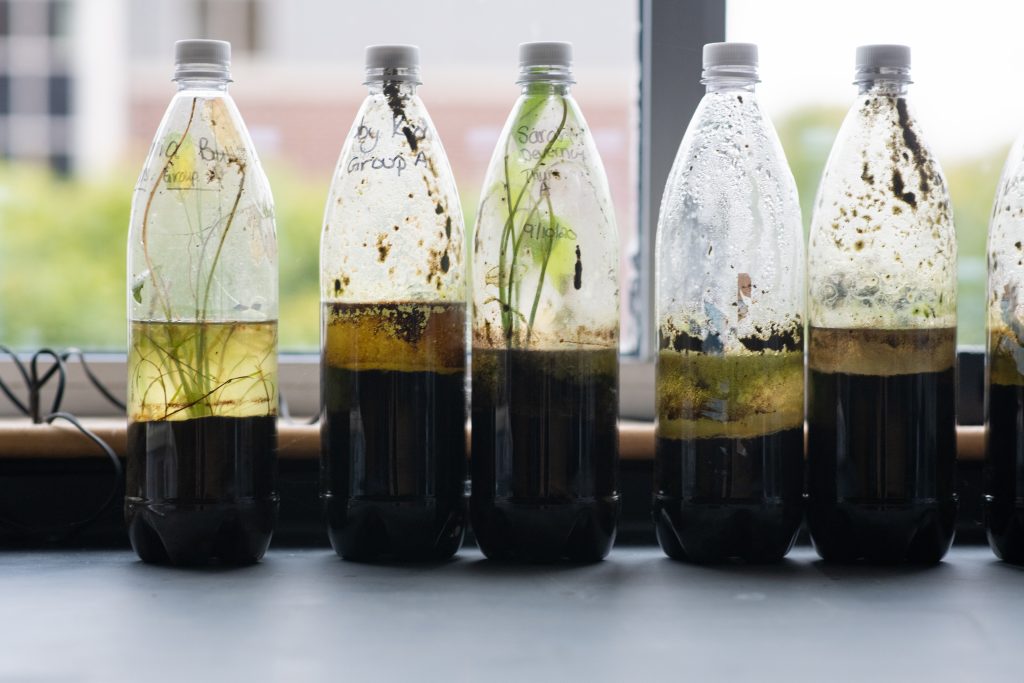
On Tiny Earth: Tiny Earth is a project out of the University of Wisconsin at Madison of students and faculty who are trying to find microbes in the soil that produce antibiotics to treat disease. The goal is to learn how to find what’s in the soil that might fight disease and, if we’re lucky, produce it. My goal is to run it here in my microbiology lab.
Students choose what route they want to take with the microbes they collect from the soil and make their own decisions on how to grow them and study them. I went through the training last summer and am trying it now with one research student. She has her sample of earth and will decide what options to take. She’s already found bacteria that turn purple, yellow, or pink in their growth media, which is really cool to look at. So far, she has 13 samples of soil bacteria growing in the lab. The next step is to see if any are making and releasing compounds that kill other bacteria.
On cooperation in COVID-19: Of course we’d rather not have a horrible pathogen on our hands. But what we saw with COVID-19 was a breaking of scientific barriers. Biomedical research is competitive, and there’s always the race to make the next big finding or to create the next cure.
But with this pandemic, we saw competition put aside for cooperation. We saw scientists putting their own work on hold to focus on SARS-CoV-2 and COVID-19. We saw companies sharing information and resources with each other.
I think it shows that when it comes down to it, we can work together to tackle big problems. I think we also are seeing that people do want access to scientific information that they can trust. I know I’ve never been asked as many questions about viral biology and immunology as I have been over the last 18 months. There is a real desire by the general public to understand the science that impacts their everyday lives. With that door open, I think that provides scientists with opportunities to engage more with the public and perhaps build more bridges between scientists and nonscientists.
By Jane Gottlieb

